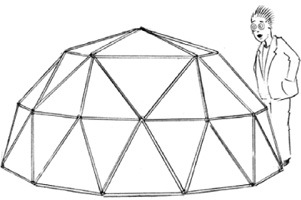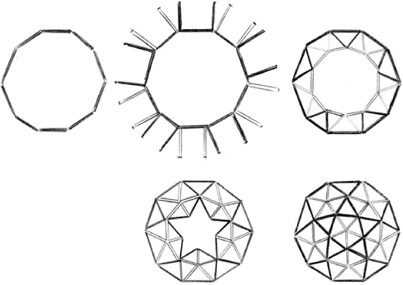

According to my meagre research, Buckminster Fuller never made a dome out of hockey sticks, undoubtedly because he was too busy inventing more things based on triangulation and explaining his name. A geodesic dome is an icosahedron, which, hellish on spellcheckers and the mathematically challenged as it may be, is simply a shape with twenty planes. Bucky (as he was called by his friends) patented the icosahedron known as the geodesic dome in the 1950s. A dark rumor persists that it was in fact first designed by the Zeiss optical company in Germany in the 1920s: the Bowlhaus School of Design, if you will.
To plan the dome, you must set aside any psychoactive components of your life because you will have to do a lot of exact measuring. Domes can be made in various sizes and complexities. For the sake of (relative) simplicity, you will work with two stick lengths. To calculate what these lengths should be, you must decide on the radius of your dome. The actual formulas used to figure out lengths and angles involves math and symbols that are so confusing I thought I was looking at a handbook dropped from a UFO. Luckily for all of us, there are several calculators that do just this on the Web — search on “Geodesic Domes, how to build.”
The next problem is how to connect these sticks, and because the sticks come into many of the junctions from five different directions, the unions require a lot of fidgeting. Modern technology has come to the rescue, however: use duct tape. Sources can be found for manufactured connectors if you want a more permanent structure — first, remember that the length of the arms of the connectors will affect the total length of the struts. But you somehow got the idea that you can make a geodesic dome with duct tape. These structures are amazingly strong, but the strength of a dome with duct tape connectors will be proportional to your taping virtuosity.
DARK STICKS = LONGER STICKS (71 CM)

Making a geodesic dome requires sixty-five pieces of hockey stick, no matter how big a dome you want to build: 35 71-cm pieces and 30 66-cm pieces will yield a dome about 2 metres across. (Since this is science, it’s all done in metric.) As you assemble the dome from the ground up, one thing will be pretty clear: you have too much time on your hands, and you need to find someone similarly gifted to assist you. Beginning with a circle made of 10 of the longer pieces, you progressively build up the dome as illustrated. It is a process of bracing, connecting, and using profanity that would make a pirate blush, but perseverance will pay off. Eventually you will have a half-sphere suitable for child’s play or horseplay. Once you resume your indulgence in psychoactives (apparently a characteristic of dome dwellers), you will notice a heck of a lot of pentagons, pentagrams, and maybe even a few pentameters, depending on your stash.